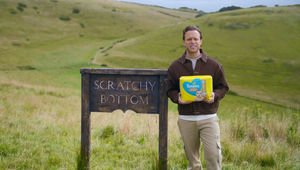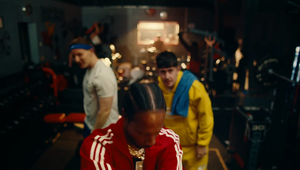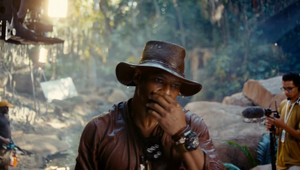
The World Through Karima Asaad’s Lens

Karima Asaad describes her life’s experiences as constantly shifting like a fever dream. But within that, there are a few consistencies that remain. She loves capturing flamboyance in art, and is obsessed by the seemingly contradicting states of the outrageous and the structured, the clean and the filthy. She’s also drawn to indecorum, dirty jokes, and people who embrace their inner child.
It was at 21 that Karima was thrown headfirst into photojournalism as she roamed the world, meeting all varieties of strangers and asking if she could photograph them. She explains that one day she thought, “What if I could make these photos more theatrical?” It was that spark of curiosity that would lead her into advertising. “I’ve always wanted the people to see the world through my lens; to see the raw, unfiltered me,” Karima explains. Over time, she began to weave stories through her work, “turning snapshots into narratives”.
Since then, she’s remained dedicated to telling stories that arouse real emotion – marrying together everything she learns from the world around her in a way that can connect with individuals and brands.
In this interview, we speak to Karima to find out more about the director and photojournalist who has just joined the Great Guns roster.
LBB> You've worked in various territories around the world. How does this international experience influence your photographic and directorial style?
Karima> Travelling the globe and diving into international markets is a mind-bending trip. It blows open your perspective, forcing you to see the world through a kaleidoscope of cultures. You learn to connect disparate threads, finding common ground in the most unexpected places. It’s more than just staying up to date with the latest trends and styles; it’s about absorbing the pulse of different societies, soaking in their essence, and letting that influence your creative madness. It keeps your edge razor-sharp and your work bursting with fresh, vibrant energy.
LBB> How do you navigate the different demands and creative processes between photojournalism and creative advertising?
Karima> Navigating the demands and creative processes between photojournalism and creative advertising is like walking a tightrope strung between two distinct worlds. In photojournalism, it's all about capturing unfiltered truth. You’re in the trenches, documenting reality as it unfolds, with an eye for the moment that tells the story. It demands a certain level of detachment, an ability to observe without interfering.
Creative advertising, on the other hand, is a beast of a different nature. Here, you’re crafting a vision, shaping reality to tell a compelling story that grabs attention and sells a message. It’s more controlled, more polished, and requires a deep understanding of the audience's mind.
Balancing these two realms involves embracing their unique demands while staying true to my creative core. It's about knowing when to step back and let the story reveal itself, and when to step in and mould it with a bold, imaginative touch. The key is maintaining that authenticity, whether capturing the grit of the real world or conjuring up a vivid, theatrical scene.
LBB> What do you consider your most significant achievement, and what impact did it have on your career?
Karima> I’d say the real game-changer was focusing on my mental health. Taking care of my mind gave me the emotional bandwidth and the breathing room I needed to unleash my creativity. It opened up a space where I could truly express myself, unburdened by the chaos that once clouded my thoughts. This clarity allowed me to dive deeper into my work, exploring new depths and pushing boundaries I never thought possible. It's the foundation that supports everything I create.
LBB> With a diverse range of clients from The New York Times to Commonwealth Bank, how do you tailor your approach to fit each client's unique needs?
Karima> My mission is to create work that's brutally true to myself. They come to me for the raw, unvarnished truth, and that's what I deliver. I refuse to bend to conventional standards or water down my vision. It's about staying true to my wild, chaotic soul and letting that authenticity shine through every piece. I won't compromise or conform. My work is a reflection of who I am, and that’s what makes it stand out in a world drowning in mediocrity.
LBB> As a photographer and director, how do you ensure that your work respects and accurately represents the cultures and stories you capture?
Karima> Research. Research. Research. And a hell of a lot of observing. I immerse myself in the subject, becoming a part of it. I aim to capture the raw, unfiltered truth, never distorting the lens. My goal is to document reality as it is — gritty, vibrant, and unapologetic. It’s about finding the essence and freezing it in time, without any artificial gloss.
LBB> What new trends or technologies in photography excite you, and how do you incorporate them into your work?
Karima> I'm all about ChatGPT. It's been a game-changer for articulating my work. As someone who's neurodivergent, it helps me get my thoughts across and frees up more time for my creative chaos.
LBB> How do you approach storytelling differently when working on a single image versus a series or a multimedia project?
Karima> My approach to image creation is all about storytelling. I get the talent to re-enact the narrative, and whether it's a series or a single shot, I aim for the most impactful moment that nails the story. By capturing a sequence of actions and reactions, we eventually strike gold — the perfect moment that tells the tale. But we don’t dive into photography thinking we’ll end up with just one shot. It’s an unpredictable journey of discovery.
LBB> Who are some photographers or visual artists that have inspired you, and how have they influenced your work?
Karima> David LaChapelle, with his shock factor and vibrant style, grabs me every time. His work is a neon explosion that challenges conventions and forces you to confront your own limits. David Fincher's voyeuristic elements and intense grip on the viewer's psyche are a trip. He dives deep into the dark corners of the human mind, pulling out truths that are both disturbing and fascinating. And Annie Leibovitz — her graceful, surreal intimacy in photography is like a dreamscape I never want to leave. She captures the soul of her subjects, creating a connection that's both tender and profound.
LBB> Can you share a project that was particularly meaningful to you and why it stood out?
Karima> The Modibodi x Puma collaboration was a wild, groundbreaking ride. It gave me the chance to tackle a taboo that desperately needed the spotlight. There was a mountain of misinformation about the menstrual cycle and women's needs, but I think we blew some myths out of the water and empowered women when they needed it most.
LBB> Looking ahead, are there any specific themes or stories you're eager to explore in your future work?
Karima> I'm neck-deep in themes of empowerment and cultural identity these days. The ego, with its twisted branches and multifaceted grip on culture, has me utterly captivated. It's a wild ride through the human psyche.















